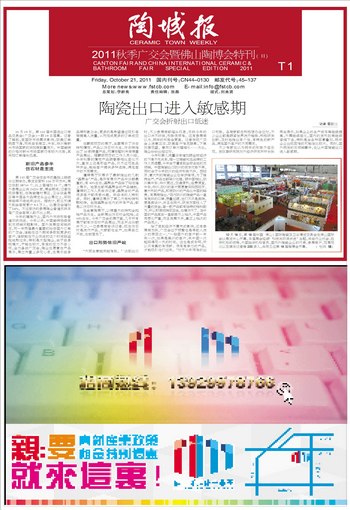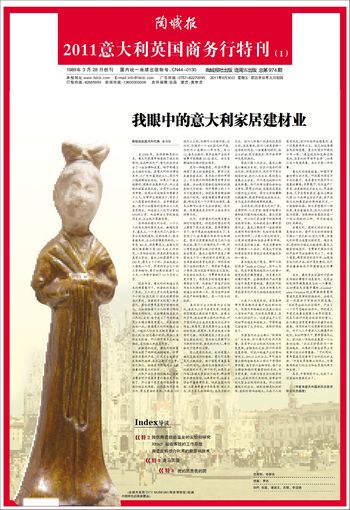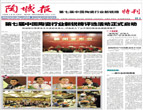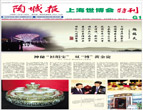When seven years ago I came to Foshan for the first time, it was for obvious reason – buying porcelain tiles. For the next few years I was involved in exporting them to my homeland – Poland. In the meantime the city of Foshan has become my sec-ond home.
Foshan porcelain tiles industry is a very good example of China economic growth's strong and weak points. The big manufacturing potential, rich vari-ety of products and still relatively low prices are the obvious advantages of Foshan tiles manufacturers in particular and Chinese export oriented industry in general.
It is still amazing for me how quickly they adjust their designs and technologies to changing demands of their various clients. The flexibility of porcelain tiles industry is indeed one of its strongest points. But there are still some serious issues, which require a lot of efforts to be made. The most ob-vious one - and it does not only con-cern the porcelain tiles industry - is al-most total lack of efforts to promote Chinese brand names on international markets so they could gain a global recognition like so many Western or Japanese brands.
We all know that every kid in the Universe is familiar with brands like Coca Cola, Sony, BMW or Nokia. Un-fortunately, China, despite its enor-mous potential - in financial or human aspect - still did not managed to build a global recognition for at least one global brand. Some reasons are under-standable, like lack of experience of Chinese companies in designing and executing professional promotional campaigns on global scale. But here there are many ready examples how to do it effectively once a strategic deci-sion is made.
I am old enough to remember Japan or South Korea, for example, which not so long ago, and I mean some 40 years ago, they are famous in the world just for umbrellas, wigs, calculators or nail clippers. But thanks to their enormous efforts no one now thinks of Japan or South Korea as an umbrella producer because they have successfully build such brand names like Toyota, Sony, Samsung, Hyundai, etc. And their recipe for a success was, paradoxical-ly, not so complex. It is not a secret for anyone that they based their brands in electronics or auto industry on foreign technologies, so they did not need to invent them. What they actually did was to develop them further, pay particular attention to quality and then to combine corporate goals with state support in order to present them to the world in a very coordinate effort as a product "made in Japan" or "made in Korea". And this is the road which, not only in my view, China not only should but would have to follow if she is seriously thinking of winning in a global compe-tition game.
There are technologies available to be upgraded, no doubt about it. How-ever, the weak point is that R&D abil-ity of Chinese industries is still very immature. The porcelain industry is a very good example, most of the latest designs and technologies are rather copied from foreign sources instead of being invented or at least upgraded by Chinese companies. Equally important is the issue of quality. It is not a secret that in some parts of the world "made in China" products are still a synonym of cheep, poor quality stuff rather than a reliable, top quality goods. This is of course gradually changing, but too slowly and everyone knows that to change deeply rooted stereotypes is extremely hard, although not impossi-ble.
We know very well, that some products of the Foshan porcelain in-dustry have already reached a top level of quality and there should be no prob-lem with promoting them as such. But the problem is, as I see it so often, that the local manufacturers very easily a-gree to sell their products under foreign brand names of their clients so the real manufacturer name is either unknown to the buyer or hidden somewhere very deeply. So a vicious circle is created, where foreign sellers still build their brands using quality Chinese products and Chinese manufacturers of those products are afraid to insist on keeping their brand names in order not to lose a client.
This vicious circle has to be broken and it would be possible as soon as the third condition is applied. And by this I mean the urgent need to assemble manufacturers into groups (i.e. like Ko-rean chebols), which should give them necessary strength to impose some conditions on foreign buyers. Once this stage is reached no one would even think of hiding a brand name of manu-facturer once it is a synonym of top quality, top technology and top design. Like no one would ever dare to remove or hide a name of Mercedes Benz on the car. Once the last condition - strong support of state in promoting "made in China" brands and products as globally recognized brands – is also fulfilled, then the future of Chinese industries, including porcelain tiles, would be bright and secure. Otherwise, as we know, competitors would not waste their time.
Countries like Brazil, Indonesia, India or Mexico are stepping up efforts to build their brand names on a porce-lain tiles market, not to mention Italian or Spanish manufacturers who already have established brand names and are constantly exploiting a "tradition" slo-gans to convince customers to choose their products. Even though we all know that most of their products are in fact made in China. Maybe then it is the right time to invest more effort, time and money in foreign companies that would promote Foshan porcelain tiles in their countries under the brand names of their real Chinese manufac-turers. That, in my opinion, can only bring a lot of benefits to Foshan manu-facturers in a long term span.
My homeland, Poland, which is al-so one of the big porcelain tiles manu-facturers, felt a lot of impact because of competition from China. Frankly speak-ing, cheaper Chinese tiles put Polish tiles manufacturers in a lot of trouble. They can not lower the costs of pro-duction to the Chinese level, so the on-ly way to compete with Chinese prod-ucts is again - original design, original technology and top quality. It took them some time to understand it and put it into practice but once they man-aged to survive an initial flood of cheaper Chinese tiles they are now do-ing better and better. And that is some-thing which sooner or later, as I already mentioned, China will face too. And not only because of a global competition. It is also because of the maturing domes-tic Chinese market where more and more middle class clients expect also Chinese products to be of top quality and contemporary, trendy design.
I do not know if my observations would be of any use to the readers but I know one thing for sure - I wish China well.When as a student of Chinese lan-guage at the Warsaw University in Poland I came to China for the first time in 1980。It was, of course, a country completely different from the China of today, and I do not think I need to ex-plain why. For someone like me, who has read lots of books about ancient China and its great inventions, and as the most developed and technologically advanced power in the world till the end of 18th Century, the transformation which took place here in last thirty years could only convince me that my choice to study Chinese and to live in China was absolutely right. While working as a correspondent for Polish media in Beijing for almost twenty years I had unique opportunity to ob-serve the reforms and opening of the country from the perspective of top level politics. I would not deny that it was extremely useful experience but once I decided to give up journalism, "xia hai" and move to Foshan seven years ago a completely new picture of China unveiled itself to me. China of businesspeople not politicians, China of hard working people not office clerks, China of heat radiating factories not air conditioned offices. When in Beijing I thought that I already know everything about China. But once I landed here in Foshan, I only began to understand what an enormous job has already been done and how equally enormous and difficult job is still to be done to make China a country up to the aspirations of her people.
Most of my Chinese friends ask me if I like it here. What kind of a question is that? How could I stay here for a bigger part of my life without enjoying it.There are many reasons. No language barrier, that's the simplest one. As for the businessman - potential is here, future is here and money is here, no doubt about it. As for me as a father - China is the safest place to raise kids. As for a person - I really like Chinese people attitude of avoiding stress and their distance from little daily troubles, which is a very serious problem for Western civilization. Not to mention of course, the best food in the world and fun I always have as a "laowai", which means someone who is an object of constant attention and curiosity to any-one I meet or pass by. Sure, they are al-so things I do not like or miss here. As much as Foshan is concerned my two biggest complains are also, unfortu-nately, linked with a porcelain industry. The first is pollution, of air and soil. I always remind my Chinese friends that nothing comes for free - especially such a rapid development like China is undergoing now. Western countries have also paid enormous price for their development, destroying almost every forest, poisoning almost every river, ruining the natural environment of fau-na and flora, polluting air, farming fields, etc. The fact that we, Western-ers, are wiser now and demand from others to care about C02 emissions or so, does not change the fact that re-pairing all the damage costs Western countries enormous money and efforts. China, in some cases, is unfortunately repeating these mistakes and Foshan, with its constant smog, is not en ex-ception. I know that technologies to filter air and to neutralize pollutants are expensive and that to modernize or even close the most outdated factories does not come free of charge. But I also know that it is still better and cheaper to prevent than to cure, as the old say-ing goes.
My second concern is something, which is very typical for foreigners coming to China. They look here for things Chinese - silks, teas, porcelain, straw hats, lacquer ware, pagodas and dragons - because it is how Europe and the Western world perceived China for centuries. Unfortunately, silk robes are gone, porcelain has been replaced by glass or plastic, folk handicrafts and hand made traditional objects are either completely gone or more and more dif-ficult to find. I have to admit that it was a kind of a shock to me when I came to China, the homeland of porcelain, only to find out that instead of sipping tea from fragile porcelain cups most people use Nescafe glass jars for this purpose. Foshan is famous for its Shiwan pottery but for last seven years I see a sad phe-nomenon how highly artistic, quality objects are giving way to a cheap, mass produced "souvenirs", which has al-most nothing to do with a porcelain as we know it. This sad development al-ready happened in Jindezhen, where state owned manufactures of splendid hand painted "wanshou" imperial read or yellow porcelain tableware practi-cally collapsed and now the market of-fers only cheap copies of that treasures, usually made of plastic and with a printed pattern. This is enormous pity and I hope that local ceramic tiles in-dustry, hand in hand with local author-ities, will develop a coordinated pro-gram to protect Shiwan manufactures, their artisans, traditional technologies and designs from the collapse and dis-appearance. Not to mention the need for much more active international pro-motion of Shiwan porcelain art as the treasure of not only China but whole human civilization. I am myself an avid collector of Shiwan porcelain figurines and I hope that these beauties would become better known to people around the world because they really deserve it. They are many ways to promote a culture and I am also myself an example of businessman who tries to combine business with something, which other people may enjoy and benefit from, in a human sense.. Few weeks ago, with a group of investors from Poland, we have opened in the Foshan Creative Park a restaurant called "Sarmatia". This is not the only Polish restaurant in Fos-han or Pearl River Delta but the very first Polish restaurant in the whole Chi-na. Business it is, of course, but my idea is that 'Sarmatia", as a such u-nique place in China, should not only be just a restaurant but also kind of cultural center, where Chinese people can not only taste original Polish dishes but also get acquainted with Polish culture - music, dances, songs, films, folk costumes and handicrafts, our his-tory and festivals, etc. In that way I want to create " a little Poland " in Fos-han, first of all for my Chinese friends, to let them know more about my coun-try. But also for myself because I can at last eat bread, sour rye soup, pork chop and other traditional Polish dish-es, and believe me that is what I missed a lot in China too.
And now, once the restaurant is open, I have even more reasons to think of Foshan as my second home and to plan my business and personal future here.
KRZYSZTOF DAREWICZ – graduate of the Sinology Department of the Warsaw University in Poland. Former correspondent of the Polish Press Agency in Beijing and Pyongyang. Former correspondent of the Polish daily “Rzeczpospolita” in Washington D.C. Former political commentator of CNN and BBC World for Far Eastern affairs. Author of numerous articles in international syndicated newspapers and magazines like Newsweek, Wall Street Journal, Far Eastern Economic Review, National Geographic Magazine , New York Times, Die Welt, etc. Lecturer at many European and Asian universities, author of books about Hong Kong and North Korea. Currently a Director of the Darsin Consulting International Co., LTD in Honkong and Darsin Trading Co., LTD in Poland. Expert of the Polish Association of Employers and Entrepreneurs, Vice Chairman of China-Central Europe Economic Forum. He is also a main character of last year HBO TV documentary movie “One Billion Happy People”.
Special Observer :KRZYSZTOF DAREWICZ Translator:Zhuo Guangxun
![]()







